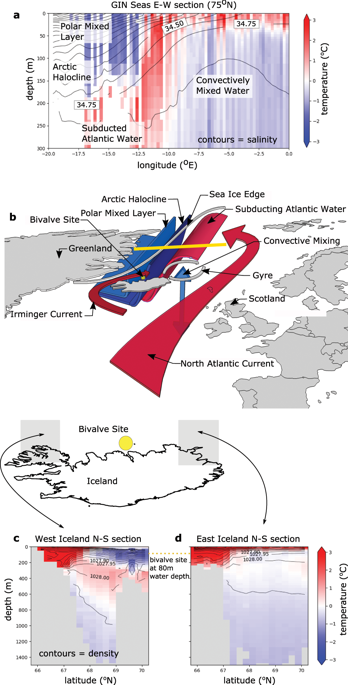Our official English website, www.x-mol.net, welcomes your
feedback! (Note: you will need to create a separate account there.)
Natural drivers of multidecadal Arctic sea ice variability over the last millennium.
Scientific Reports ( IF 3.8 ) Pub Date : 2020-01-20 , DOI: 10.1038/s41598-020-57472-2 Paul R Halloran 1 , Ian R Hall 2 , Matthew Menary 3 , David J Reynolds 2, 4 , James D Scourse 5 , James A Screen 6 , Alessio Bozzo 7 , Nick Dunstone 8 , Steven Phipps 9 , Andrew P Schurer 10 , Tetsuo Sueyoshi 11, 12 , Tianjun Zhou 13 , Freya Garry 1
Scientific Reports ( IF 3.8 ) Pub Date : 2020-01-20 , DOI: 10.1038/s41598-020-57472-2 Paul R Halloran 1 , Ian R Hall 2 , Matthew Menary 3 , David J Reynolds 2, 4 , James D Scourse 5 , James A Screen 6 , Alessio Bozzo 7 , Nick Dunstone 8 , Steven Phipps 9 , Andrew P Schurer 10 , Tetsuo Sueyoshi 11, 12 , Tianjun Zhou 13 , Freya Garry 1
Affiliation

|
The climate varies due to human activity, natural climate cycles, and natural events external to the climate system. Understanding the different roles played by these drivers of variability is fundamental to predicting near-term climate change and changing extremes, and to attributing observed change to anthropogenic or natural factors. Natural drivers such as large explosive volcanic eruptions or multidecadal cycles in ocean circulation occur infrequently and are therefore poorly represented within the observational record. Here we turn to the first high-latitude annually-resolved and absolutely dated marine record spanning the last millennium, and the Paleoclimate Modelling Intercomparison Project (PMIP) Phase 3 Last Millennium climate model ensemble spanning the same time period, to examine the influence of natural climate drivers on Arctic sea ice. We show that bivalve oxygen isotope data are recording multidecadal Arctic sea ice variability and through the climate model ensemble demonstrate that external natural drivers explain up to third of this variability. Natural external forcing causes changes in sea-ice mediated export of freshwater into areas of active deep convection, affecting the strength of the Atlantic Meridional Overturning Circulation (AMOC) and thereby northward heat transport to the Arctic. This in turn leads to sustained anomalies in sea ice extent. The models capture these positive feedbacks, giving us improved confidence in their ability to simulate future sea ice in in a rapidly evolving Arctic.
中文翻译:

在过去的千年中,北极年代际海冰多变性的自然驱动力。
气候因人类活动,自然气候周期以及气候系统外部的自然事件而异。了解这些可变性驱动因素所起的不同作用,对于预测近期气候变化和极端变化以及将观测到的变化归因于人为或自然因素至关重要。诸如大型爆炸性火山爆发或海洋环流的数十年周期之类的自然驱动因素很少发生,因此在观测记录中的代表性很差。在这里,我们来看看上个千年以来第一个每年解析和绝对过时的高纬度海洋记录,以及同一时期的古气候模拟比对项目(PMIP)第3阶段最后一个千年气候模型合集,研究自然气候驱动因素对北极海冰的影响。我们表明,双壳类动物的氧同位素数据记录了北极北极年代际冰的多变性,并且通过气候模型集合证明了外部自然驱动因素最多可以解释这种多变性。自然的外部强迫会导致海冰介导的淡水向活跃的深度对流区域的出口变化,从而影响大西洋子午翻转环流(AMOC)的强度,从而向北向北极输送热量。反过来,这导致海冰范围持续出现异常。这些模型捕获了这些积极的反馈,使我们对其在快速发展的北极中模拟未来海冰的能力有了更大的信心。我们表明,双壳类动物的氧同位素数据记录了北极北极海冰的数十年变率,并且通过气候模型集合表明外部自然驱动因素最多可以解释这种变率的三分之一。自然的外部强迫会导致海冰介导的淡水向活跃的深度对流区域的出口变化,从而影响大西洋子午翻转环流(AMOC)的强度,从而向北向北极输送热量。反过来,这导致海冰范围持续出现异常。这些模型捕获了这些积极的反馈,使我们对其在快速发展的北极中模拟未来海冰的能力有了更大的信心。我们表明,双壳类动物的氧同位素数据记录了北极北极年代际冰的多变性,并且通过气候模型集合证明了外部自然驱动因素最多可以解释这种多变性。自然的外部强迫会导致海冰介导的淡水向活跃的深度对流区域的出口变化,从而影响大西洋子午翻转环流(AMOC)的强度,从而向北向北极输送热量。反过来,这导致海冰范围持续出现异常。这些模型捕获了这些积极的反馈,使我们对其在快速发展的北极中模拟未来海冰的能力有了更大的信心。自然的外部强迫会导致海冰介导的淡水向活跃的深度对流区域的出口变化,从而影响大西洋子午翻转环流(AMOC)的强度,从而向北向北极输送热量。反过来,这导致海冰范围持续出现异常。这些模型捕获了这些积极的反馈,使我们对其在快速发展的北极中模拟未来海冰的能力有了更大的信心。自然的外部强迫会导致海冰介导的淡水向活跃的深度对流区域的出口变化,从而影响大西洋子午翻转环流(AMOC)的强度,进而向北向北极输送热量。反过来,这导致海冰范围持续出现异常。这些模型捕获了这些积极的反馈,使我们对其在快速发展的北极中模拟未来海冰的能力有了更大的信心。
更新日期:2020-01-21
中文翻译:

在过去的千年中,北极年代际海冰多变性的自然驱动力。
气候因人类活动,自然气候周期以及气候系统外部的自然事件而异。了解这些可变性驱动因素所起的不同作用,对于预测近期气候变化和极端变化以及将观测到的变化归因于人为或自然因素至关重要。诸如大型爆炸性火山爆发或海洋环流的数十年周期之类的自然驱动因素很少发生,因此在观测记录中的代表性很差。在这里,我们来看看上个千年以来第一个每年解析和绝对过时的高纬度海洋记录,以及同一时期的古气候模拟比对项目(PMIP)第3阶段最后一个千年气候模型合集,研究自然气候驱动因素对北极海冰的影响。我们表明,双壳类动物的氧同位素数据记录了北极北极年代际冰的多变性,并且通过气候模型集合证明了外部自然驱动因素最多可以解释这种多变性。自然的外部强迫会导致海冰介导的淡水向活跃的深度对流区域的出口变化,从而影响大西洋子午翻转环流(AMOC)的强度,从而向北向北极输送热量。反过来,这导致海冰范围持续出现异常。这些模型捕获了这些积极的反馈,使我们对其在快速发展的北极中模拟未来海冰的能力有了更大的信心。我们表明,双壳类动物的氧同位素数据记录了北极北极海冰的数十年变率,并且通过气候模型集合表明外部自然驱动因素最多可以解释这种变率的三分之一。自然的外部强迫会导致海冰介导的淡水向活跃的深度对流区域的出口变化,从而影响大西洋子午翻转环流(AMOC)的强度,从而向北向北极输送热量。反过来,这导致海冰范围持续出现异常。这些模型捕获了这些积极的反馈,使我们对其在快速发展的北极中模拟未来海冰的能力有了更大的信心。我们表明,双壳类动物的氧同位素数据记录了北极北极年代际冰的多变性,并且通过气候模型集合证明了外部自然驱动因素最多可以解释这种多变性。自然的外部强迫会导致海冰介导的淡水向活跃的深度对流区域的出口变化,从而影响大西洋子午翻转环流(AMOC)的强度,从而向北向北极输送热量。反过来,这导致海冰范围持续出现异常。这些模型捕获了这些积极的反馈,使我们对其在快速发展的北极中模拟未来海冰的能力有了更大的信心。自然的外部强迫会导致海冰介导的淡水向活跃的深度对流区域的出口变化,从而影响大西洋子午翻转环流(AMOC)的强度,从而向北向北极输送热量。反过来,这导致海冰范围持续出现异常。这些模型捕获了这些积极的反馈,使我们对其在快速发展的北极中模拟未来海冰的能力有了更大的信心。自然的外部强迫会导致海冰介导的淡水向活跃的深度对流区域的出口变化,从而影响大西洋子午翻转环流(AMOC)的强度,进而向北向北极输送热量。反过来,这导致海冰范围持续出现异常。这些模型捕获了这些积极的反馈,使我们对其在快速发展的北极中模拟未来海冰的能力有了更大的信心。











































 京公网安备 11010802027423号
京公网安备 11010802027423号